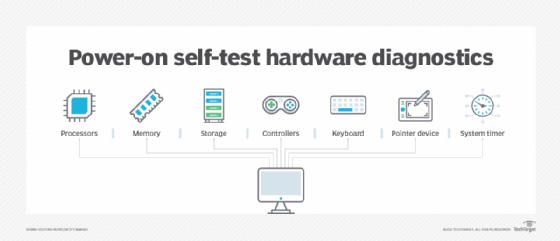POST (Power-On Self-Test)
What is Power-On Self-Test (POST)?
A Power-On Self-Test (POST) is an operation initiated by a computer after it has been turned on but before it boots up the OS. The computer's firmware -- BIOS, Unified Extensible Firmware Interface (UEFI) or another system -- carries out this operation by running a diagnostic testing sequence to determine if the computer's essential hardware is working properly.
Why are Power-On Self-Tests important?
Power-On Self-Tests are an essential part of system troubleshooting because the boot-up can only proceed if the software is working correctly; if the software isn't working, the BIOS produces an error message. This is important because numerous essential programs are loaded when systems boot up.
When a POST is completed successfully, bootstrapping -- which starts the initialization of the boot-up -- is enabled. In computing, bootstrap means to boot or load a program, usually an OS, onto a computer using a much smaller initial program.
Computers aren't the only devices that use POSTs. Some appliances, medical equipment and other hardware run similar self-tests after being turned on.

How Power-On Self-Tests work
The way in which a computer carries out the POST process depends on the system's hardware architecture and installed firmware. Generally, the process verifies the viability of all the hardware necessary to ensure the OS and applications can run properly. This typically includes the following devices:
- processors,
- memory,
- storage,
- controllers,
- keyboard,
- pointer device and
- system timer.
The exact list of hardware devices will depend on the system. A POST operation might also perform other tasks, such as verifying the firmware, validating hardware configurations or initializing the hardware.
During the POST process, a user might see some indication that it's underway. For example, hardware lights might flash, or the screen might display a company logo. However, today's computers are so fast that they usually zip right through their POST operations with little indication, unless there's a problem. If the necessary hardware is detected and operating properly, the computer continues with the rest of the boot process.
If the specified hardware isn't detected or operating properly, the firmware usually stops the boot process and issues an error message. The message might be displayed on the computer's screen, sent as a series of coded beeps or both, depending on the nature of the problem. Because the POST operation runs before the computer's graphics card is initialized, it might not be possible to display error information on the screen, in which case, the computer uses only beeps.
The pattern of beeps depends on the system architecture, the type of firmware installed and vendor choices. In general, the pattern is meant to reflect the type of error or at least provide a general sense of where to look for the error. For example, the system might emit three long beeps if there's a problem with the keyboard card or one long and two short beeps if the problem is related to the display adapter.
An error found during the POST operation is usually fatal and will halt the boot process. This is because the hardware being checked is essential for the computer's functions. For the same reason, other types of electronic devices might also run POST operations when they start up.
See also: beep code, serial presence detect, motherboard tattoo
